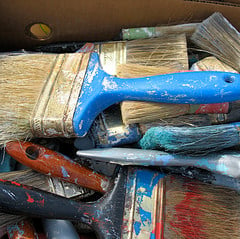Choosing A Good Paint Brush
 Although it might seem that you could use any paint brush to paint your home, the brush you choose can be as important as the project itself. It doesn't make much sense to buy a top quality paint, and then apply it with a really cheap paint brush or roller. The quality of the results you achieve will be much better with a top quality paint brush.
Although it might seem that you could use any paint brush to paint your home, the brush you choose can be as important as the project itself. It doesn't make much sense to buy a top quality paint, and then apply it with a really cheap paint brush or roller. The quality of the results you achieve will be much better with a top quality paint brush.
A great paint brush will hold more paint, give you more control, provide a smoother finish with fewer brush strokes and will save you time. As with anything, you get what you pay for when it comes to paint brushes.
The main differences in paint brushes will be the bristle types, the taper, bristle flagging or splitting, bristle density, the ferrule and balance.
Bristle types
There are many different types of bristles. Hog hair (or china bristle), polyester, nylon and blends. China bristle is actually hog hair. It is the best when using oil-based paint because the hog hair is stiff enough for control but soft and naturally splits at the ends for a very smooth application. Hog hair cannot be used for water-based paints however because the bristles absorb water. Polyester bristles are generally stiff. These bristles provide good control but often are too stiff for a smooth application. Nylon bristles are very soft, which make for very smooth application but are too flimsy for control. The best synthetic brushes contain a blend of polyester and nylon bristles. The polyester provide the stiffness for control while the nylon bristles provide the softness for a very smooth application. Varying quality of the filaments will also affect how well the paint flows off the bristle (called the "release").
Taper
A good brush will taper so that the brush is actually thicker at the bottom and narrower at the top. This shape gives the brush more stiffness and control. A cheap brush will generally have bristles of all the same length. A good quality brush will have a finer tapered edge and longer bristles than the cheaper kinds.
Bristle flagging
Flagging, or split ends, is what you see at the tips of the bristles. Flagging is when the bristles are scored or split at the end to provide finer and smoother application. Great paint brushes have flagged or split bristles whereas a cheap paint brush will not.
Bristle density
The more bristles a paint brush has the better (too a point). Paint is held in the space between the bristles, so more bristles will hold more paint. This allows the paint to flow from the brush, giving you more control, smoother application and longer time for holding your line. You'll achieve a straighter and cleaner edge and spend less time filling your brush and more time painting. A cheaper paint brush won't hold much paint and therefore is more or less smearing the paint rather than flowing the paint onto the surface.
Ferrule
The ferrule is the area of the brush that holds the bristles against the handle. Ferrules are commonly metal and are either square or rounded. Good paint brushes will have either a stainless steel or other rust-proof ferrule whereas a cheap brush will use a lower quality metal that is more subject to rusting. The shape of the ferrule will have an impact on the shape of the bristles. It isn't necessarily important whether it is square or rounded, and often is just a matter of personal preference.
Balance
Most handles are made of rubber or wood. What you want in paint brushes is a balanced brush that feels comfortable in your hand and is easy to control.
The Right Size
Your surface will determine what type of brush you use. If you have a wide surface you will want to use one of the larger 3-4 inch brush. If you need to trim around paneled doors you will want a smaller 1 ½-2" brush. The most popular brush size is a 2-inch angled sash brush because it is comfortable to use and hold and can be used to trim around tight areas.
